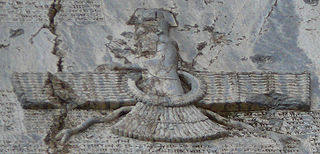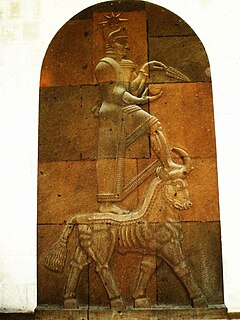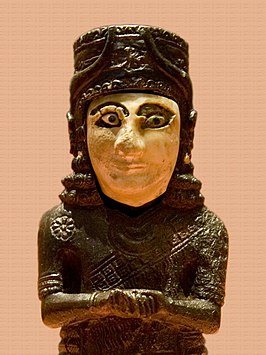
Sargon was an Assyrian king. A son of Tiglath-Pileser III, he came to power relatively late in life, possibly by usurping the throne from his older brother, Shalmaneser V. Sargon II suppressed rebellions, conquered the Kingdom of Israel, and, in 710 BC, conquered the Kingdom of Babylon, thus reuniting Assyria with its southern rival, Babylonia, from which it had been separate since the death of Hammurabi in 1750 BC.

Arame or Aramu was the first known king of Urartu.

The Mannaeans were an ancient people who lived in the territory of present-day northwestern Iran south of lake Urmia, around the 10th to 7th centuries BC. At that time they were neighbors of the empires of Assyria and Urartu, as well as other small buffer states between the two, such as Musasir and Zikirta.

Theispas of Kumenu was the Araratian (Urartian) weather-god, notably the god of storms and thunder. He was also sometimes the god of war. He formed part of a triad along with Khaldi and Shivini. The ancient Araratian cities of Teyseba and Teishebaini were named after Theispas. He is a counterpart to the Assyrian god Adad, the Vedic God Indra, and the Hurrian god, Teshub. He was often depicted as a man standing on a bull, holding a handful of thunderbolts. His wife was the goddess Huba, who was the counterpart of the Hurrian goddess Hebat.

Argishti I, was the sixth known king of Urartu, reigning from 786 BC to 764 BC. He founded the citadel of Erebuni in 782 BC, which is the present capital of Armenia, Yerevan. Alternate transliterations of the name include Argishtis, Argisti, Argišti, and Argishtish.

Erebuni Fortress, also known as Arin Berd, is an Urartian fortified city, located in Yerevan, Armenia. It is 1,017 metres (3,337 ft) above sea level. It was one of several fortresses built along the northern Urartian border and was one of the most important political, economic and cultural centers of the vast kingdom. The name Yerevan itself is derived from Erebuni.
Ishpuini was king of Urartu. He succeeded his father, Sarduri I, who moved the capital to Tushpa (Van). Ishpuini conquered the Mannaean city of Musasir, which was then made the religious center of the empire. The main temple for the war god Haldi was in Musasir. Ishpuinis and his nation were then attacked by the forces of the Assyrian King Shamshi-Adad V. Ishpuinis fought and defeated Shamshi-Adad. Ishpuini was so confident in his power that he began using names meaning everlasting glory, including, "King of the land of Nairi", "Glorious King", and "King of the Universe".
Sarduri III was a king of Urartu between 639 BC and 635 BC.
Rusa III was king of Urartu. He was called "Son of Erimena," meaning that he was probably a brother of Rusa II. Little is known about his reign; his name was inscribed on a massive granary at Armavir and on a series of bronze shields from the temple of Khaldi found at Rusahinili, now held in the British Museum. According to the Armenian historian Moses of Chorene, Rusa's father Erimena can probably be identified with Paruyr Skayordi, who helped the Median king Cyaxares to conquer Assyria, for which Cyaxares recognized him as the king of Armenia, although the Medes ultimately reneged on this; significantly later, during the reign of King Astyages, the Medes conquered and annexed Armenia.

The Kelashin Stele found in Kelashin, Iraq, bears an important Urartian-Assyrian bilingual text dating to c. 800 BC, first described by Friedrich Eduard Schulz in 1827. Part of Schulz's notes were lost when he was killed by Kurdish "bandits", and later expeditions were either prevented by weather conditions or Kurdish brigands, so that a copy of the inscription could only be made in 1951 by G. Cameron, and again in 1976 by an Italian party under heavy military protection.

Tushpuea is an Araratian (Urartian) goddess from which the city of Tushpa derived its name. She may have been the wife of the solar god Shivini as both are listed as third, in the list of male and female deities on the Mheri-Dur inscription. It is hypothesized that the winged female figures on Urartian ornaments and cauldrons depict this goddess.
Sidekan also called Bradost, a vast sub-district belongs to Soran District (Diana-Rawanduz) north of Erbil in Iraqi Kurdistan, with 250 villages, and population of less than 15000. the exact number of Bradostian people estimated more than this census but as the original inhabitants had been deported three times in 1961, 1978 and 1988 and a lot of them has not returned yet due to the frequently bombing by Turkish and Iranian army on the Kurdistan Workers Party strongholds located in Khakurk mountains, and also because of the lack of renovation projects by the local authorities.

The economy of Urartu refers to the principles of management of Urartu, the ancient state of Western Asia which existed from the thirteenth to the sixth century BC. It peaked around the eighth century BC but was destroyed with the fall of the state about a century later. The economy of Urartu was typical of ancient Middle East despotism and was closely associated with that of neighboring Assyria.

The art of Urartu refers to a historical and regional type of art from Urartu (Ararat), the ancient state of Western Asia which existed in the period from the 13th to the 6th centuries BC in the Armenian Highland. The art of Urartu was strongly influenced by nearby Assyria, the most prominent state of that period in the region. It peaked around the 8th century BC but was mostly looted, scattered and destroyed with the fall of Urartu about a century later.

Rabat is a city in the north east of Sardasht County, West Azerbaijan Province, in road of sardast - mahabad Kurdistan of Iran. In 2015, its population was 19,350, in 2,901 families.Peoples of rabat are Kurds that speak by Mokryan accent

Argishtikhinili was a town in the ancient kingdom of Urartu, established during the expansion of the Urartians in the Transcaucasus under their king Argishti I, and named in his honour. It lasted between the 8th and 6th centuries BC. The ruins of the Argishtikhinili fortifications are 15 kilometres (9 mi) southwest of the present-day town of Armavir, Armenia, between the villages of Nor-Armavir and Armavir in the Armenian marz of Armavir. The town was founded on the left bank of the middle reaches of the Aras River. Over the centuries, the river channel has shifted to several kilometres south of the town.















